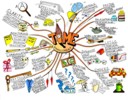Mind Maps
A Powerful Approach to Note Taking
Related variants: Spray Diagrams, Spider Diagrams, Spidograms, Spidergrams and Mindmaps
See how to construct a Mind Map. |
Mind Maps are more compact than conventional notes, often taking up one side of paper. This helps you to make associations easily. And if you find out more information after you have drawn the main Mind Map, then you can easily add it in.
Mind Maps are also useful for:
- Summarizing information.
- Consolidating information from different research sources.
- Thinking through complex problems.
- Presenting information in a format that shows the overall structure of your subject.
Drawing Simple Mind Maps

- Write the title of the subject you're exploring in the center of the page, and draw a circle around it. This is shown by the circle marked 1 in Figure 1, above.
- As you come across major subdivisions or subheadings of the topic (or important facts that relate to the subject) draw lines out from this circle. Label these lines with these subdivisions or subheadings. These are shown by the lines marked 2 in Figure 1.
- As you "burrow" into the subject and uncover another level of information (further subheadings, or individual facts) belonging to the subheadings above, draw these as lines linked to the subheading lines. These are shown by the lines marked 3 in Figure 1.
- Finally, for individual facts or ideas, draw lines out from the appropriate heading line and label them. These are shown by the lines marked 4 in Figure 1.
Note that the idea of numbered 'levels' in Figure 1 is only used to explain how the Mind Map was created. All we are showing is that major headings radiate from the center, with lower level headings and facts branching off from the higher level headings.
While drawing Mind Maps by hand is appropriate in many cases, software tools like MindGenius improve the process by helping to you to produce presentation quality Concept Maps, which can easily be edited, distributed and redrafted.
Improving your Mind Maps
Once you understand how to make notes in the Mind Map format, you can develop your own conventions to take them further. The following suggestions may help to increase their effectiveness:- Use single words or simple phrases for information: Most words in normal writing are padding: They convey facts in the correct context, and in a format that is pleasant to read. In your own Mind Maps, single strong words and meaningful phrases can convey the same meaning more potently. Excess words just clutter the Mind Map.
- Print words: Joined up or indistinct writing can be more difficult to read.
- Use color to separate different ideas: This will help you to separate ideas where necessary. It also makes your Mind Map easier to remember. Color also helps to show the organization of the subject.
- Use symbols and images: Where a symbol or picture means something to you, use it. Pictures can help you to remember information more effectively than words.
- Using cross-linkages: Information in one part of the Mind Map may relate to another part. Here you can draw in lines to show the cross-linkages. This helps you to see how one part of the subject connects with another.
Key points:
If you do any form of research or note taking, try experimenting with Mind Maps. You will find them incredibly useful!


